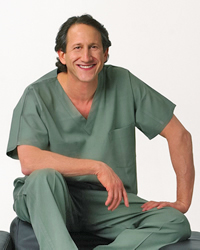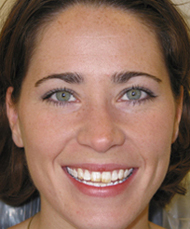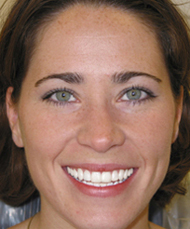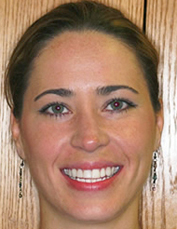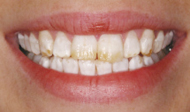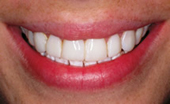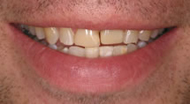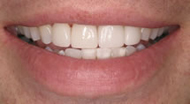Featured Client: Lorin Berland, DDS
Mari Reed, co-owner of SmilePix, recently spoke to Dr. Lorin Berland about using photography and digital imaging in his cosmetic case presentations. Dr. Berland is the creator of the Lorin Library Smile Style Guide and the Interactive Smile Style Guide. He has graciously consented to let us share his experience with our readers.
Mari: Dr. Berland, I'd like to start by asking some questions about your photography process.
Dr. Berland: To begin with, getting a good photo is the key to the whole process. That is the best place to start.
Mari: Do you photograph every patient?
Dr. Berland: Yes - We take pictures of everybody, because we keep records of everyone in the Dexis Digital Hub - their intraoral photos, their full-face photos, and their radiographs. That way we can pull it up at any time. When I have to talk to a patient, or work with a specialist, it really helps if I can see their face, their teeth, and their x-rays, all on the screen. And I can e-mail them as well.
Mari: I assume you also get better at taking pictures, when you photograph everyone, because you're taking a lot of photos.
Dr. Berland: Exactly - the more pictures, the better...just like dentistry, the more you do it, the better you get - that's why they call it a practice!
Mari: What do you say to the patient - do you tell your patient what the purpose of the photo is before taking it?
Dr. Berland: We just tell them it's for our records. And certainly, if they are considering any smile enhancement, it's a great benefit to them if we take photos first.
Mari: Who takes the pictures?
Dr. Berland: Everybody takes the distal pictures, everbody except me - and the main reason is that my time is too valuable. It's really not rocket science to take photos. Everyone in my office takes pictures: the dental assistants, the hygienist, the front desk. The world is full of amateur photographers, but not amateur dentists. I have to devote the time I've got to doing dentistry, not to taking photos.
Mari: Do you have a special area where you take the photos?
Dr. Berland: We take the intraoral pictures in the chair, but we don't make a big deal about the full-face photos, we just put them in the hall and take it. We take full-face photos in the hall, not while the patient is in the dental chair, because we like to have a solid background. It just looks better. We don't have a special studio, or special lighting or anything like that, we find that the plain background in our hallway works fine.
Mari: Do you also find you can get a better photo because they're more relaxed when they're not in the chair?
Dr. Berland: Definitely - it's hard to take a good full-face picture in the chair. Not only is the patient more likely to be tense, but it's difficult to get the right angle for the full-face, as well as a proper background.
Mari: Do you find that patients respond more positively to a full face photo rather than a close-up?
Dr. Berland: Absolutely. It's said that people make decisions on how to spend their money based on emotion, then justify it by logic. If their eyes aren't in the photo, then there's no emotional connection. Also, when we do imaging, we're trying to demonstrate how changes to their teeth can enhance their whole facial appearance, and you miss the point of that if you're just showing them a close-up.
Mari: Do you ever have trouble getting them to smile?
Dr. Berland: Yes, occasionally, but we just say something silly to loosen them up. Another thing we sometimes do is tell them to close their eyes, and then we count to three, and on the count of three they open their eyes, and that's when we snap it - so that's a good one to get their eyes open. I'm sure Sam has some better tips than me, when it comes to getting them to smile.
Mari: Sam (co-owner of SmilePix) has taken hundreds of portraits. He says, "It's a cliche, but getting them to simply say "CHEESE" really works well."
Dr. Berland: Yes, that's a good one to get a nice full smile. But even with a great smile, if the eyes are closed it detracts, so we like to do the eyes closed, and then 1-2-3...
Mari: Do you feel that it's important to get a smile portrait that is flattering to the patient?
Dr. Berland: We always make it a point - and this is very, very, important - that the patient has to like their full-face portrait. Because if you use a picture that they don't like, you're not going to be able to get teeth that look good. If they don't like the photo, they're not going to like anything you propose - I've seen that happen.
Mari: Anything else you're looking for in the photo?
Dr. Berland: You have to have a space between the incisal edge and the lower lip. You can't have the lower lip covering the incisal edge - that's the thing to look for, from a dental standpoint. Other than that, they just have to have a natural, good-looking smile - the bigger, the better!
Mari: How do you decide which photos to have imaged (i.e. do you image everyone, or just people that have already expressed an interest in cosmetic enhancements?)
Dr. Berland: We'll image anyone I think I can do something with cosmetically.
Mari: Do you show the photo to the patient to see if they like it before you send it to be imaged?
Dr. Berland: Yes - usually just on the camera's LCD screen, but sometimes on the computer screen.
Mari: Do you charge the patient for imaging?
Dr. Berland: No, but we always charge for consultations. The imaging is complimentary.
Mari: When do you present the photo simulations to the patient?
Dr. Berland: We send them by email if the patient is anxious to see the proposed result. Otherwise, we send a letter (marked "personal and confidential"), with other information on the proposed treatment - we keep it very low key.
Mari: Do you send the 'before & after simulation' to the lab?
Dr. Berland: Yes, I always send the 'before and after simulation' to the lab. It helps the lab immensely in a number of ways. First and foremost, it allows the ceramist to see a real person, not just impressions and a stone model. This has to help the ceramist understand the importance of what they are doing. They are helping to change these people's lives for the better, permanently (we hope). We also like to include a wax-up with the impression. If we make a lot of changes to the temporaries to satisfy the patient, we will include another impression of the altered provisionals. However, since we've implemented cosmetic imaging, along with the Lorin Library Smile Style Guide with regards to shape and length variations, we rarely have to adjust the temps.
Mari: Some dentists hesitate to use imaging because they are afraid they won't be able to achieve the proposed results. Have you ever had an imaging done that you didn't think was achievable? If so, what did you do? (i.e. ask for a redraw? Not show the patient the simulation? Show patient but explain that actual results will differ? etc.)
Dr. Berland: All of the above. The only time I do not show the patient is if the full face portrait is unattractive. Then I take a new picture. And generally speaking we find the end results are better looking than the cosmetic simulation, because they are real!
Mari: Can you estimate the average time lapse from presentation to case acceptance?
Dr. Berland: It can be one hour to years - impossible to tell. I recently had a patient come in seven years later, with the "before and after" photos in hand! That's part of the value of giving them the simulation. You know that old saying "out of sight, out of mind" is true. Sometimes they can't afford the smile makeover they want right away, but having the "before and after" pictures helps them to "keep their eyes on the prize" - it can inspire them to find a way to pay for it. Care Credit, a patient payment plan, has been fantastic for my practice. But, as I said earlier, we keep it very low key - we don't want to be perceived as "selling" them procedures they don't want, just showing them what's possible if they decide they do want to proceed with treatment.
Mari: What made you decide to create the Lorin Library Smile Style Guide?
Dr. Berland: I noticed sometimes that when a patient wasn't exactly happy, I didn't quite know what it was: the color was right, the function was right, but maybe what was "off" was the shape of the maxillary incisors and canines, and/or the length variation between the centrals, laterals, and canines. Some are taught in dentistry that they should be almost straight across, with maybe 1/2 mm shorter on the laterals. But some people have long centrals, and sometimes they're longer than the canines, and if somebody wants a more youthful look, that's what they were looking for.
Another thing we're taught is that men have square teeth and women have round teeth, and that's not necessarily true - a lot of women like square teeth. Or maybe someone's teeth were long and round at one time, then over time they wore down and became square and flat, and the canines might have originally been pointed and then became flat. If I were to make centrals that were round and they expected them square or vice versa, we have a problem.
So I find that if you do imaging, and you get the patient involved at the very beginning by choosing the shape of the canines that they find attractive, then select the shape of their incisors, and then the various lengths between the centrals, laterals, and canines, then your odds of having a pretty happy patient when you're done, will certainly increase, because they were included in the process of the smile design from the beginning.
Mari: Could you tell us more about how you use the Lorin Library in conjunction with SmilePix Imaging in your treatment planning process?

Dr. Berland: Whatever the patient decides, whether they want to do two, four, six, eight, ten or more
teeth, they must first take ownership of the treatment. For example, let's say you just do four, and then they're dissatisfied because, for whatever reasons, you didn't create what they wanted, whether it's the number and the various shapes and/or lengths of the treated teeth, the color of the treated as well as the untreated teeth, whatever...there are a lot of variables. You want to introduce and discuss all of these options at the beginning. It's too late afterward. Then you're making excuses. That's why cosmetic imaging is so important. You must first decide how many teeth you need to do. Do they like the bicuspids? Is there silver showing? Are the canines short, flat? Are these teeth too dark? How about the lower teeth? Maybe we should bleach all of these these teeth prior to any restorative treatment on the teeth chosen for transformation?
